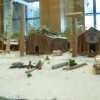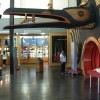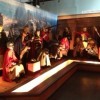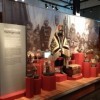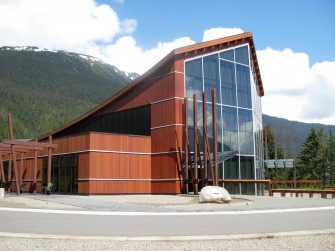Nisga’a Museum
The Nisga’a Museum and its collections are directly related to the historic Nisga’a Treaty. The museum’s permanent collection is an assemblage of 300+ artifacts and art objects that left the Nass (Lisims) Valley in the latter part of the 19th Century and early part of the 20th Century. While many priceless heirlooms, ceremonial objects and cultural icons were destroyed by missionaries during this tumultuous period several works of art and cultural significance found their way into the collections of private individuals and museums around the world. Their return to traditional Nisga’a land is significant. Through the treaty process a select number of objects were identified and chosen from the collections of the Royal British Columbia Museum and Canadian Museum of Civilization to be repatriated to Nisga’a territory. This unique collection of carved masks, bentwood boxes, headdresses, soul catchers, and other works of art became known as Anhooya’ahl Ga’angigatgum’ – the Ancestors’ Collection. This collection, and its display, is a focal point within the museum.
The Nisga’a Museum is also known as Hli Goothl Wilp-Adokshl Nisga’a, which means “The Heart of Nisga’a House Crests,” a name that acknowledges and celebrates the importance of the four tribes that make up the Nisga’a nation. The four tribes or Pdeek are: Ganada (raven), Gisk’aast (killer whale), Laxgiik (eagle) and Laxgibuu (wolf). Each Pdeek has a crest or Ayukws – an animal that symbolically represents each tribe. The museum displays and incorporates all the Nisga’a crests and the people they represent within its permanent exhibition, the Ancestors’ Collection.
The design of the museum and its central exhibition are closely linked to the Nisga’a way of life. Inspired by the traditional longhouse and feast dish, the 929-square-metre museum fuses these two designs together to create a unique architectural presence within the Nisga’a landscape. Hillel Architecture’s Peter Hardcastle developed the design of the museum in consultation with Nisga’a elders and other community stakeholders. The Ancestors’ Collection exhibition was designed by Alan Graves and Kevin Neary. The museum’s exterior landscape was designed by Duane Ensing. The museum, its contents and surrounding environment are symbolic of sayt k'il'hl wo'osihl Nisga'a or “common bowl” philosophy that all people, animals, lands and the environment are all inter-connected and common, collective property. This idea is imbedded within the Nisga’a Nation’s vision statement one heart, one path, one nation.


